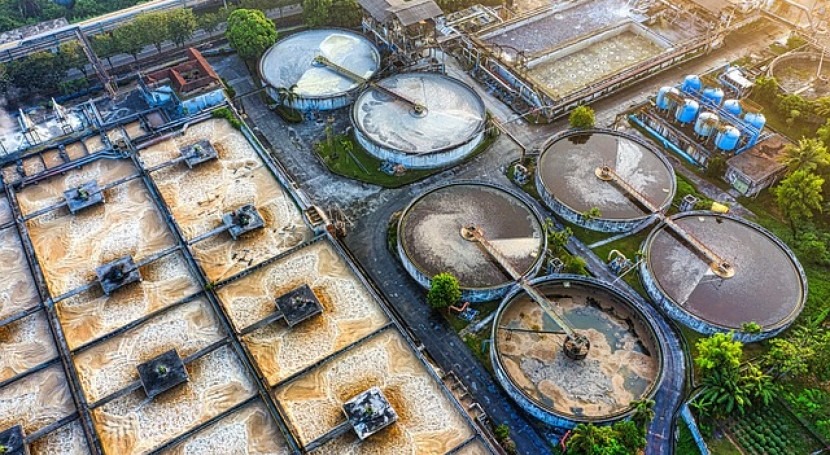Trick Obstacles in Urban Waste Water Treatment Strategies
Trick Obstacles in Urban Waste Water Treatment Strategies
Blog Article
Strategic Approaches to Enhance Drainage Treatment Performance and Minimize Environmental Effect
In the world of drainage therapy, the quest for enhanced performance and reduced ecological impact is a perpetual challenge that requires calculated solutions. As society faces the important to handle water resources sustainably, a nuanced method ends up being crucial. The assimilation of innovative therapy modern technologies, energy-efficient procedures, resource healing techniques, improved nutrient removal techniques, and smart monitoring and control systems stands for a multifaceted structure for addressing these pushing problems. What exists at the core of this facility web of techniques is the potential to change the means we come close to waste water treatment, not simply as a procedure of disposal, but as a valuable possibility for advancement and ecological stewardship.
Advanced Treatment Technologies
Advanced membrane filtration systems have actually changed innovative wastewater treatment procedures, substantially enhancing the removal of pollutants. This modern technology has actually proven to be highly effective in removing a large range of impurities, including pharmaceuticals, hefty metals, and organic substances, which are frequently testing to remove via typical treatment approaches.
In addition, membrane layer filtration systems supply many benefits over traditional therapy methods. They need much less space, create higher-quality effluent, and are much more immune to changes in influent water quality. Furthermore, these systems are very flexible and can be conveniently integrated right into existing treatment plants or made use of as standalone devices for decentralized applications. As the demand for tidy water continues to increase, the adoption of sophisticated membrane layer purification technologies is vital to ensure sustainable and effective wastewater therapy practices.
Energy-Efficient Procedures
The assimilation of energy-efficient procedures in wastewater therapy systems is essential for optimizing resource use and decreasing functional costs. One crucial strategy to boosting power efficiency in wastewater therapy is the usage of sophisticated oygenation systems, such as great bubble diffusers or surface area aerators, which can boost oxygen transfer effectiveness and lower power usage.
Moreover, enhancing procedure control and automation through using advanced sensing units and checking systems can improve overall power performance by adjusting procedures in real-time based upon actual need and conditions. Carrying out power audits and frequently keeping an eye on power performance signs are crucial practices to determine areas for renovation and track energy-saving campaigns properly. Overall, the fostering of energy-efficient procedures in wastewater therapy not only benefits the environment however additionally adds to lasting cost financial savings and functional sustainability.
Resource Recovery Techniques
With a concentrate on maximizing source utilization and sustainability in wastewater therapy systems, the execution of resource healing strategies emerges as a crucial element in enhancing functional effectiveness. Resource recuperation methods in wastewater treatment entail the identification and extraction of useful resources from the waste stream, therefore transforming what was once taken into consideration waste into a valuable property. By applying resource recuperation methods such as nutrient elimination and healing, power generation from raw material, and the production of multiple-use water, wastewater treatment plants can decrease environmental influence while taking full advantage of efficiency.

Improved Nutrient Elimination Strategies
Implementing advanced nutrient removal methods is necessary for maximizing the effectiveness of wastewater therapy systems. Enhanced nutrient elimination plays a critical duty in lessening the environmental influence of cured effluent discharged right into water bodies. Among the essential strategies utilized for enhanced nutrient removal is the procedure of biological nutrient removal (BNR), which entails the elimination of nitrogen and phosphorus with biological procedures. This can be accomplished with making use of specialized bacteria that can transform nitrogen substances right into inert nitrogen gas through denitrification, and accumulate phosphorus within their cells via a process called boosted biological phosphorus elimination (EBPR)

In enhancement to BNR, progressed therapy approaches such as membrane layer bioreactors (MBRs) and constructed marshes can likewise be employed to boost nutrient removal performance. By including these innovative nutrient elimination strategies right into wastewater treatment systems, industries and towns can properly lower nutrient pollution and shield the setting.
Smart Surveillance and Control Solution
Utilizing advanced innovation, the integration of clever tracking and control systems reinvents the operational performance of wastewater therapy centers. These systems integrate sophisticated sensors and information analytics to continuously keep track of vital criteria such as pH degrees, turbidity, liquified oxygen, and flow prices in real-time. By collecting and examining this information, operators can get beneficial insights right into the performance of the therapy procedures, allowing positive changes to optimize treatment performance.
Smart surveillance and control systems also sustain remote surveillance capabilities, allowing operators to access real-time data and control features from off-site areas. This remote ease of access improves operational flexibility and responsiveness, allowing swift interventions in case of system malfunctions or changes in influent high quality. The anticipating upkeep abilities of these systems assist my company protect against devices failures and minimize downtime, eventually improving the general reliability of wastewater therapy procedures.
Conclusion
In verdict, strategic approaches such as innovative treatment innovations, energy-efficient procedures, source recovery strategies, boosted nutrient removal techniques, and wise surveillance and control systems play a critical duty in enhancing wastewater therapy performance and lessening environmental influence. By executing these strategies, wastewater treatment plants can boost their general performance, decrease power consumption, recover useful resources, and guarantee conformity with ecological policies. These methods are essential for sustainable and efficient wastewater administration techniques.

In final thought, tactical techniques such as innovative therapy modern technologies, energy-efficient processes, source recuperation methods, improved nutrient removal methods, and clever monitoring and control systems play a vital function in improving wastewater treatment effectiveness and minimizing environmental influence.
Report this page